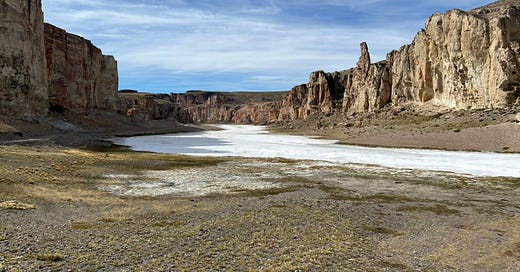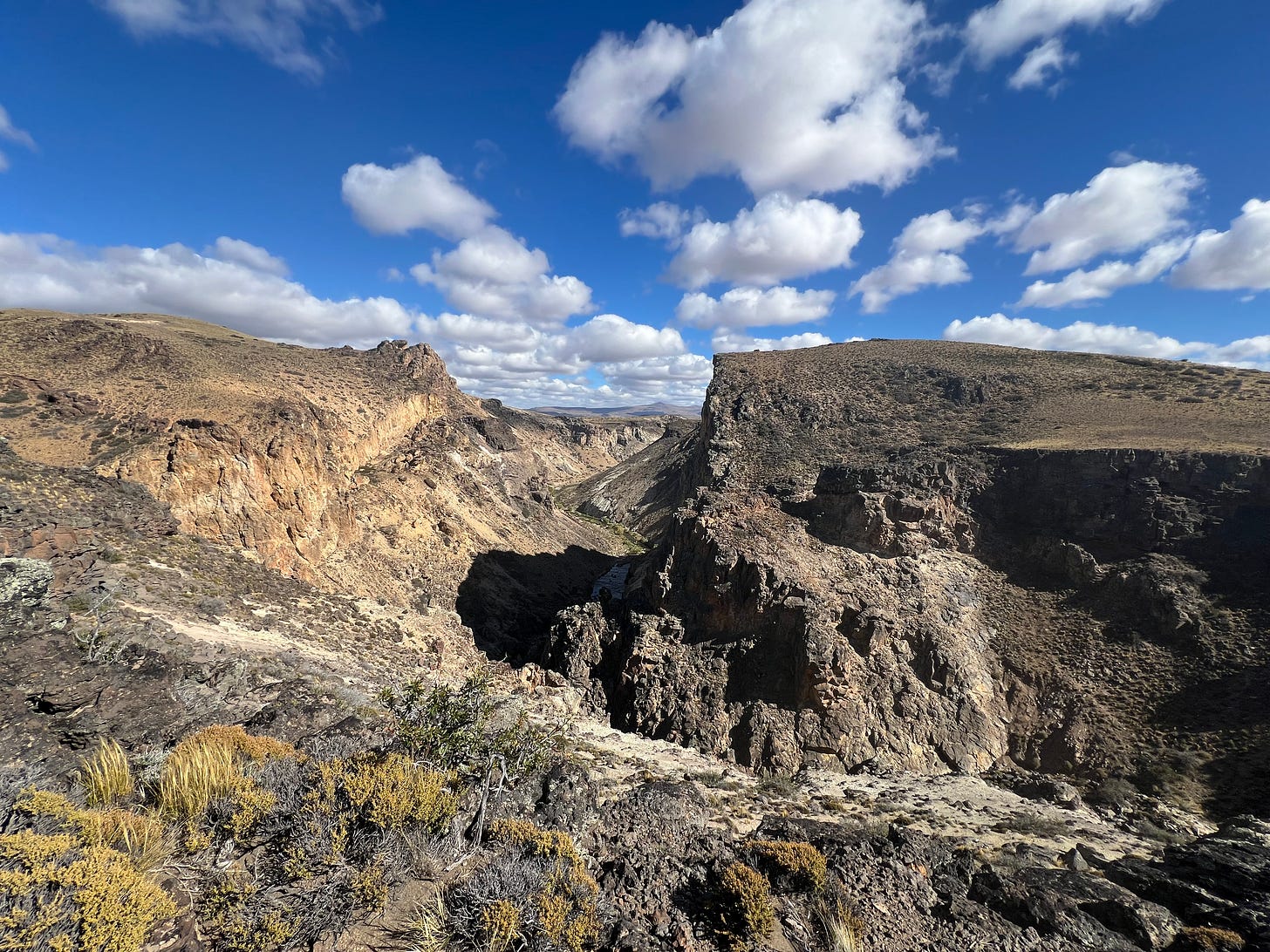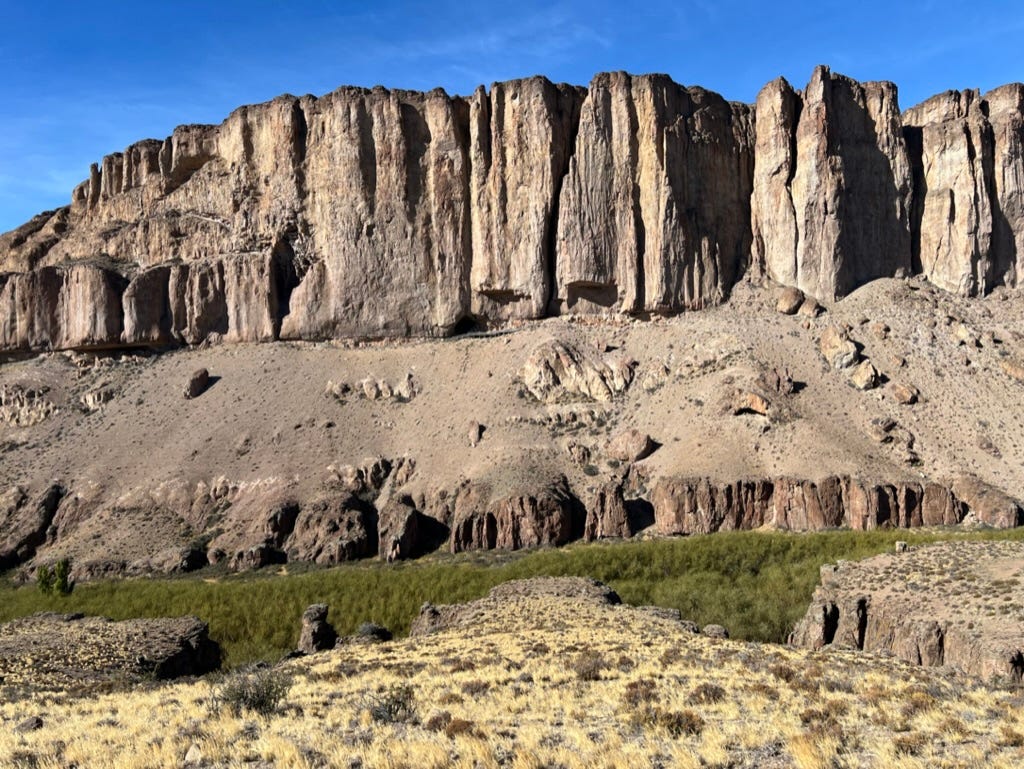Leaving behind the dramatic cliffs and the ocean-scented air of the Patagonian coastline, we began our journey inland toward the heart of Parque Nacional Patagonia. The journey was not just one across kilometers but across landscapes that seemed to shift with each turn of the road, offering an unbroken view of the land that stretched to the edge of the world. The steppe, with its wide-open spaces, windswept grasses, and jagged horizon, is often described as a blank canvas, but in truth, it is far from empty. It is a living, breathing landscape, shaped by millennia of natural forces and human intervention.
Driving away from the coast, the wind seemed to carry everything with it, from the fresh scent of saltwater to the faintest trace of earth. As we moved further into the steppe, the land began to reveal its subtle beauty. Here, the vast openness can feel like both an invitation and a challenge. The wide, flat terrain feels almost infinite, broken only by low, scrubby bushes, occasional rock outcrops, and a sky so expansive it seems to stretch into another time zone. It’s a landscape that whispers the stories of those who have lived here before—the indigenous Tehuelche people, who traveled the land in small groups for thousands of years, and the settlers who arrived from Europe, seeking cheap land but unknowingly altering the region’s delicate ecosystem in profound ways.
The steppe has borne the weight of human history—cattle ranchers, sheep herders, and the practices of unsustainable farming that have plagued the region for generations. For much of the 20th century, this land was used primarily for grazing, with introduced species such as sheep and cattle displacing the native flora and fauna. The land, once rich with biodiversity, suffered under the strain of over-exploitation. But in the past few decades, thanks to organizations like Rewilding Argentina, a concerted effort to restore this vast wilderness has gained momentum. The park was founded in 2019, and its goal is to not only protect but to restore the ecological balance of this region—a region that had been impacted by human activities for over a century.
Driving into the Parque Nacional Patagonia, the landscape began to change, slowly at first and then with more definition. As we entered the park, the flat steppe slowly gave way to more varied terrain: rocky outcrops, small valleys, and the distant rise of the Andes Mountains. The wind still howled across the land, but it now felt like the land itself was settling, preparing to tell us its next story. The transition from the coast to the mountains here is something more than just a geographical shift; it is a meeting of ecosystems, a junction where the sea’s salt and the mountains’ coolness collide.
But beyond the breathtaking scenery, what drew me most to this place was the work being done to restore and protect it. As we met our guide for the day, Jorge Maldonado, a self-taught biologist and conservationist, it became clear that this wasn’t just about land. It was about restoring life, piece by piece. We were here to explore the wetlands restoration project, one of the cornerstones of the Rewilding Argentina effort.
The Wetlands Project: Reclaiming the Life of the Land
The wetlands of Patagonia are critical, but for years, they were neglected, drained, and often considered useless. Much of the land had been converted into ranches, where vast herds of sheep and cattle roamed, leaving little room for the delicate ecosystems that once thrived in the region. The result was a loss of biodiversity that hit the wetlands hardest. Wetlands, with their rich vegetation and water systems, are incredibly important for filtering water, providing habitats for wildlife, and acting as carbon sinks. But for too long, these wetland areas were drained to make way for agricultural expansion, further contributing to the decline of species and the erosion of the natural landscape.
Through the restoration project, Rewilding Argentina is working to bring back the life that was once lost. What was once a drained, barren landscape is slowly beginning to show signs of rejuvenation. Native grasses, shrubs, and trees are being replanted, and the wetlands are being re-wetted—allowing water to flow back through the ecosystem. Already, birds that hadn’t been seen in the area for decades are returning, and the once-quiet wetland is now a humming network of life, teeming with insects, plants, and animals. The restoration project is as much about reintroducing biodiversity as it is about healing the land that has been damaged. It is a long-term project, one that will take years, perhaps decades, to fully restore. But in the midst of it, a transformation is already happening.
Tracking Sable: The Puma in the Land of Wildness
In addition to the wetland restoration, the work being done here to bring back the region’s apex predators is equally as impressive. Pumas, or mountain lions, are an essential part of this ecosystem. They help keep the population of guanacos and other herbivores in check, maintaining a healthy balance between predator and prey. But for years, pumas were hunted, driven away by ranchers looking to protect their livestock. Even today, many people still harbor a deep mistrust of the big cats, believing they pose a threat to farming interests. Yet, the return of pumas to the land is crucial to the long-term health of this ecosystem.
We were out today to track one particular puma known as Sable. The biologists at Rewilding Argentina had fitted her with a collar, tracking her movements through the park.
Her territory stretched across a rugged expanse of mountains, valleys, and wetlands—an ideal home for a top predator like her. As we ventured through the steppe, we followed her movements, guided by the data sent from the collar. Our goal wasn’t to hunt her down, but to learn from her. To understand how she moved, how she interacted with the land and its creatures, and how she fit into the delicate web of this ecosystem.
As we neared her last known position, we slowed, careful not to make any noise. Sable was close—close enough that if we tried hard enough, we could see her. But there was no need. Pumas are not meant to be viewed like zoo animals. They are wild, and the last thing we wanted to do was push her further into hiding. We knew exactly where she was, tucked between a series of low rocks, watching us carefully from the shadows. But we didn’t push forward. Instead, we stayed still, respecting her space, letting her be.
At that moment, I realized something important about the work of Rewilding Argentina: it’s not about control, it’s about respect. It’s about allowing the wild to exist without interference. We were witnessing the true wildness of this land, where the goal isn’t to dominate or own but to protect and observe. We could have forced a sighting of Sable, but that wouldn’t have been a true success. Instead, the real success was knowing she was there, thriving in her natural habitat, untouched by our presence.
The Road Ahead: A Wild Future
As we left the puma behind, we began to talk more about the larger vision for the park and its restoration. The wetlands, the predators, and the biodiversity that is returning to the land are all part of a greater vision. It’s a vision that involves long-term commitment—not just to land conservation but to rewilding entire ecosystems. What’s happening in Parque Nacional Patagonia is more than just a local project; it is part of a larger, global movement that seeks to restore balance to the natural world.
But for all the progress that has been made, much work remains. The restoration of wetlands is a slow process, and the work with apex predators like pumas is ongoing. It will take years, decades even, for the full effects to be seen. But the commitment of those involved in this project is palpable, from the biologists tracking Sable to the local communities working to restore their lands. Rewilding Argentina has already made a tremendous impact, but it’s only just beginning.
What I witnessed today, walking through the steppe and tracking Sable, was a reminder of the wildness that still exists in the world. The winds that whip across the land, the pumas in the mountains, the wetlands slowly coming back to life—these are the stories that should be told. And as I left Parque Nacional Patagonia, I couldn’t help but feel inspired. This is how we make space for the wild to thrive again. It starts with respect, patience, and a deep understanding that the land is not ours to control, but to protect. The wild is resilient, and it’s coming back—one step at a time.







